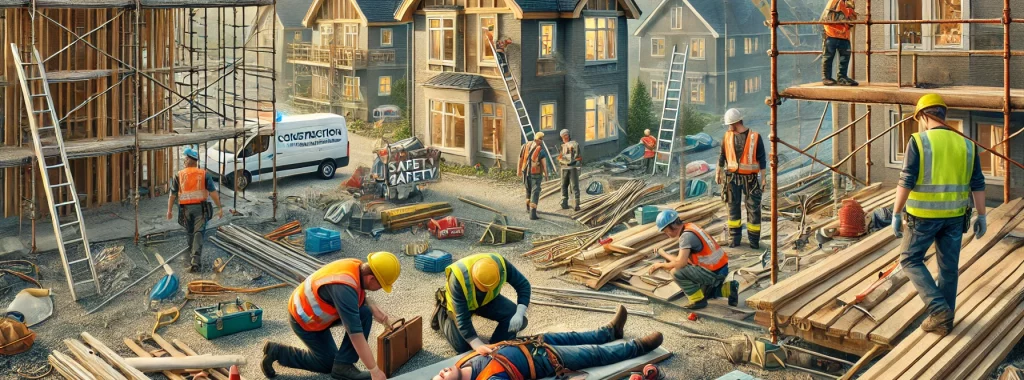
Residential Construction Injuries: Legal Advice for Homebuilders and Owners
Residential construction is a high-risk industry in the United States due to exposure to work-related
safety hazards and fall injuries. In New York City, residential construction is particularly hazardous
due to renovation work performed at heights. Both homebuilders and owners have a responsibility
to keep the job site safe.
Common Injuries at Residential Construction Sites
According to the U.S. National Institute for Occupational Safety and Health (NIOSH) and the U.S.
Occupational Safety and Health Administration (OSHA), falls from heights remain the leading
cause of work-related injuries and fatalities among construction workers employed on residential
projects. This is particularly true in New York City, where falls occur from scaffolding during
residential renovation.
In fact, residential construction workers’ falls from height account for 64% of the fatalities in
residential buildings, according to the U.S. Bureau of Labor Statistics. Workers can experience falls
from the roof, from a ladder, from scaffolding or staging, through floor openings, and from other
types of falls.
For example, in June 2019, construction workers using a supported scaffold to complete façade
work at a Manhattan building took a lunch break. One of the workers went back up to the scaffold
to retrieve an item, which is when he fell to his death. The New York Department of Building’s
investigation revealed that the scaffold, which exceeded 50 feet, was unpermitted and improperly
installed. It was also lacking deck boards and guardrails.
Other accidents and deaths result from the following:
- Struck by falling/non-secure materials or debris
- Electrocution
- Slips and trips
- Injuries from building materials due to lack of personal protection equipment (such as hard hats, eye protection, etc.)
- Caught in or between objects
Homebuilders’ Responsibility for Worker Safety
General contractors (GCs) are responsible for worker safety on the job site. They must have a
written safety program in place, which includes safety training. Safety training must cover
equipment safety; fall protection; ladder, scaffolding, and crane safety; first aid; forklift safety;
emergency preparedness; and hazard communication.
Regarding scaffolding safety, where many residential renovation construction injuries occur, New
York Labor Law 240 specifies that property owners and construction firms are accountable for any
gravity-related injuries suffered by workers on building sites unless the worker was at fault.
Construction firms and property owners must provide appropriate scaffolding and safety
equipment to prevent falls and other accidents.
Labor Law 240 states the following:
“Scaffolding and other devices for use of employees. All contractors and owners and their agents,
except owners of one- and two-family dwellings who contract for but do not direct or control the
work in the erection, demolition, repairing, altering, painting, cleaning or pointing of a building or
structure shall furnish or erect, or cause to be furnished or erected for the performance of such
labor, scaffolding, hoists, stays, ladders, slings, hangers, blocks, pulleys, braces, irons, ropes, and
other devices which shall be so constructed, placed and operated as to give proper protection to a
person so employed.
“Scaffolding or staging more than twenty feet from the ground or floor, swung or suspended from
overhead support or erected with stationary supports, except scaffolding wholly within the interior
of a building and covering the entire floor space of any room therein, shall have a safety rail of
suitable material properly attached, bolted, braced or otherwise secured, rising at least thirty-four
inches above the floor or main portions of such scaffolding or staging and extending along the
entire length of the outside and the ends thereof, with only such openings as may be necessary for
the delivery of materials. Such scaffolding or staging shall be so fastened as to prevent it from
swaying from the building or structure.
“All scaffolding shall be so constructed as to bear four times the maximum weight required to be
dependent from there or placed thereon when in use.”
Violations of these regulations can result in serious legal implications and financial penalties for
companies.
Property Owners’ Responsibility for Worker Safety
Property owners also are responsible for ensuring safe working conditions on job sites. As with
GCs, property owners under Labor Law 240 must provide appropriate safety equipment for
construction employees working on a scaffold and other devices on a worksite. The Labor Law
requires that scaffolding installation adhere to applicable safety standards and that all ladders,
pulleys, hoists, harnesses, and other safety devices must be well maintained and remain safe.
Under §241(6) of the New York State Labor Law, property owners and GCs must also ensure that
personnel keep the site free of debris and other physical hazards that could cause an employee to
trip, slip, or fall.
Legal Implications Related to Residential Construction Injuries
Workers injured during residential construction are entitled to Workers’ Compensation benefits,
which will pay for medical treatment, wage loss up to a certain amount, rehabilitation, and ongoing
medical treatment. Additionally, if the injury results from noncompliance with New York Labor
Laws (as discussed above), an injured worker may have a negligence case and can proceed with a
lawsuit against the general contractor and property owner for failing to maintain a safe work
environment.
Call the Law Office of Nicholas E. Tzaneteas
If you have been injured in a construction incident, call us. We specialize in helping victims of
construction accidents throughout the Bronx, Brooklyn, Queens, and Manhattan. You may be
entitled to significant financial compensation for medical expenses, lost earnings, and pain and
suffering. The Law Office of Nicholas E. Tzaneteas can offer you the legal representation required
to protect your rights.

